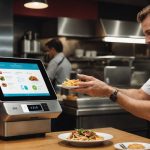Managing kitchen supplies can often feel overwhelming. However, innovative digital solutions are transforming the way we approach inventory management. By leveraging technology, you can streamline your processes, reduce waste, and make data-driven decisions. These tools not only help you keep track of supplies but also enhance efficiency and save valuable time. Discover how mastering your kitchen inventory can lead to a more organized and productive culinary environment.
Importance of Kitchen Inventory Management
Effective kitchen inventory management is a cornerstone of a well-functioning culinary environment. It plays a critical role in reducing food waste, which not only benefits the environment but also contributes to significant cost savings. By keeping track of what ingredients are on hand, kitchens can avoid over-purchasing and ensure that food is used before it spoils. This careful management of resources results in a more sustainable operation.
Also to read : Choosing the ideal Champagne: key factors to consider
In addition to waste reduction, efficient inventory management enhances overall kitchen efficiency. When ingredients are organised and easily accessible, the workflow is smoother, allowing chefs and kitchen staff to focus on cooking rather than searching for supplies. This streamlined process leads to faster service and increased productivity, which is essential in a fast-paced kitchen setting.
Moreover, well-maintained inventory systems can prevent unexpected shortages, ensuring that all menu items are available to customers. By implementing robust inventory practices, kitchens can maintain consistency in their offerings and uphold their reputation for reliability.
Have you seen this : Ultimate Guide to Selecting the Best Range Hood for Maximum Grease Protection
Ultimately, effective kitchen inventory management is not just about keeping track of supplies; it’s about creating a harmonious workflow that supports culinary creativity while also being mindful of costs and environmental impact.
Common Challenges in Kitchen Inventory
Navigating the complexities of kitchen inventory management often presents several inventory challenges. One of the most prevalent issues is the risk of supply shortages, which can disrupt service and tarnish a kitchen’s reputation. When essential ingredients run out unexpectedly, it not only affects menu availability but also leads to customer dissatisfaction and potential revenue loss.
Another challenge is maintaining an accurate inventory count. Errors in tracking can lead to overstocking or understocking, both of which have financial implications. Overstocking ties up capital in unused ingredients that may spoil, while understocking can stall operations and compromise dish consistency.
For instance, a bustling restaurant in New York struggled with these issues due to a lack of digital inventory systems. They frequently faced supply shortages, resulting in menu alterations and customer complaints. By transitioning to a digital solution, they improved accuracy, reduced waste, and enhanced service quality.
Effective management involves regular audits and leveraging technology to predict demand accurately. By addressing these challenges head-on, kitchens can ensure a steady supply chain, maintain high service standards, and enhance operational efficiency. Embracing modern inventory solutions is key to overcoming these hurdles and achieving seamless kitchen operations.
Digital Solutions for Inventory Management
In the fast-paced world of culinary arts, digital tools and inventory software have become indispensable for managing kitchen supplies efficiently. These technologies offer a range of features designed to streamline inventory processes and minimise human error.
Popular inventory management apps like BlueCart, MarketMan, and ChefMod provide comprehensive solutions tailored for the food industry. They offer real-time tracking, automated ordering, and detailed analytics, which help kitchens maintain optimal stock levels and reduce waste.
When evaluating digital solutions, consider key features such as user-friendly interfaces, integration capabilities with existing systems, and the ability to generate insightful reports. Real-time data access is crucial, enabling kitchen staff to make informed decisions quickly. Furthermore, automated alerts can prevent supply shortages by notifying users when stock levels fall below a set threshold.
Another important aspect is scalability. As your kitchen operations grow, your inventory software should be able to accommodate increased complexity without compromising efficiency.
By leveraging these digital tools, kitchens can enhance accuracy in inventory counts, improve resource allocation, and ultimately boost productivity. Embracing technology not only simplifies inventory management but also supports a more sustainable and responsive culinary operation.
Implementing an Inventory Management System
Introducing a robust inventory management system involves strategic planning and execution. Begin by assessing your kitchen’s specific needs and selecting software that aligns with these requirements. A tailored approach ensures the system supports your unique operational demands.
Steps to Set Up an Effective System
- Evaluate Needs: Identify the key areas where inventory management can improve efficiency and reduce waste.
- Choose the Right Tools: Opt for user-friendly software with integration capabilities to streamline processes.
- Data Migration: Ensure accurate transfer of existing inventory data into the new system to maintain continuity.
- Testing and Feedback: Conduct a trial run and gather feedback from staff to fine-tune the system.
Best Practices for Accurate Records
Maintaining precise inventory records is crucial. Regular audits and updates prevent discrepancies. Implement barcode scanning to minimise human error and enhance tracking accuracy. Encourage staff to report inconsistencies promptly.
Importance of Staff Training and Engagement
Staff training is vital for successful implementation. Educate employees on using the system efficiently and highlight its benefits, such as reduced workload and improved accuracy. Engaged staff contribute to a seamless transition and ongoing system success, ensuring your kitchen operates at its best.
Benefits of Using Digital Inventory Tools
Adopting digital inventory tools offers numerous advantages that significantly enhance kitchen operations. These tools streamline inventory processes by automating routine tasks, which reduces the burden on staff and allows them to focus on more critical duties. By minimising manual errors, digital solutions ensure that inventory counts are accurate, leading to better resource allocation and cost management.
One of the primary benefits of digital tools is the increased efficiency they bring to inventory management. Automated systems can quickly process data, update stock levels in real-time, and generate reports that provide valuable insights into inventory trends. This enhanced efficiency translates into time savings, allowing kitchen staff to concentrate on delivering exceptional culinary experiences.
Moreover, digital inventory tools offer increased visibility and control over stock levels. With real-time tracking features, kitchens can monitor ingredient usage, detect discrepancies, and make informed decisions to prevent shortages or overstocking. This level of control ensures that kitchens maintain optimal stock levels, reducing waste and enhancing overall sustainability.
By embracing these technologies, kitchens not only improve their operational efficiency but also gain a competitive edge in the fast-paced culinary industry. The integration of digital tools is a strategic move towards a more responsive and sustainable kitchen environment.
Case Studies of Successful Inventory Management
Exploring case studies of businesses that have transformed their inventory management through digital solutions provides valuable insights. These success stories illustrate the tangible benefits of adopting modern technologies.
One notable example is a London-based restaurant that faced significant challenges with manual inventory tracking. By implementing a comprehensive digital solution, they streamlined their inventory processes, leading to a 20% reduction in food waste. This success story highlights the importance of real-time tracking and automated ordering in maintaining optimal stock levels.
Another success story comes from a large catering company that struggled with frequent stockouts and overstocking. By leveraging a digital inventory system, they achieved a 30% increase in operational efficiency. The key strategy involved integrating their inventory software with existing procurement systems, allowing for seamless data flow and improved decision-making.
The measurable outcomes of these strategies include not only reduced waste and increased efficiency but also enhanced customer satisfaction. With consistent stock levels, these businesses could maintain menu availability, leading to better customer experiences.
These success stories demonstrate that digital solutions are not just about technology but about strategic implementation. By analysing these examples, other businesses can learn how to tailor digital tools to their specific needs, achieving similar benefits in their operations.
Integrating Inventory Management with Other Systems
Integrating inventory management with other systems such as ordering and sales is crucial for achieving optimal workflow optimization in kitchens. This integration ensures that all components of the kitchen’s operations are aligned, leading to smoother processes and improved efficiency.
By linking inventory management with ordering systems, kitchens can automate the replenishment of stock, reducing the risk of shortages and overstocking. This seamless connection allows for real-time updates on inventory levels, ensuring that orders are placed based on accurate data. Consequently, kitchens can maintain consistent stock levels, which is essential for providing reliable service to customers.
Integrating with sales systems further enhances efficiency by allowing kitchens to track ingredient usage in relation to sales data. This insight enables better forecasting and demand planning, helping to prevent waste and optimise resource allocation.
Several tools facilitate this integration, offering features such as API connectivity and compatibility with existing systems. Popular solutions include software that provides unified dashboards, enabling kitchen staff to monitor and manage all aspects of operations from a single platform.
Incorporating these system integration strategies not only streamlines kitchen processes but also supports a more responsive and efficient culinary environment, ultimately enhancing service quality and customer satisfaction.
Future Trends in Kitchen Inventory Management
The landscape of kitchen inventory management is poised for transformation with the advent of emerging technologies. As automation and artificial intelligence (AI) continue to advance, they present innovative solutions that could revolutionise how kitchens manage their inventories.
Emerging Technologies
Technologies like the Internet of Things (IoT) and machine learning are set to redefine inventory processes. IoT devices can monitor stock levels in real-time, providing accurate data to prevent shortages. Machine learning, on the other hand, can analyse usage patterns and predict future needs, enhancing decision-making.
Automation and AI
Trends in automation are making inventory management more efficient. Automated systems can reorder supplies when stock falls below a certain threshold, reducing human intervention and error. AI-powered analytics offer insights into usage trends, helping kitchens optimise their resource allocation.
Future Predictions
Looking ahead, predictions for the future of kitchen inventory management include increased integration of AI and IoT. These technologies will enable more precise forecasting and resource management, leading to cost savings and reduced waste. As these innovative solutions evolve, they will undoubtedly shape the future of culinary operations, making them more sustainable and efficient.
Practical Tips for Maintaining Inventory
Managing kitchen inventory effectively requires consistent inventory maintenance practices. Implementing daily routines for inventory checks is crucial. Begin each day by assessing stock levels and noting any discrepancies. This routine helps in identifying issues early, preventing shortages or overstocking.
Organising and categorising supplies can significantly enhance efficiency. Group similar items together and label each category clearly. Use a first-in, first-out (FIFO) system to ensure older stock is used first, reducing waste. Shelving and storage solutions should be tailored to the kitchen’s specific needs, making it easier for staff to locate items swiftly.
Forecasting inventory needs is another vital component. Analyse historical data to predict future demand. Consider factors such as seasonal variations and upcoming events that may influence ingredient usage. This strategy helps in maintaining optimal stock levels without overextending resources.
Incorporating technology can further streamline these processes. Inventory management software can automate routine checks and provide real-time data, allowing for more informed decision-making. By following these practical tips, kitchens can maintain a well-organised inventory system that supports efficient operations and reduces unnecessary costs.
Conclusion: Taking Action Towards Better Inventory Management
In the dynamic world of culinary operations, taking decisive action steps towards improving inventory management is crucial. Effective inventory systems not only streamline kitchen processes but also contribute to sustainability and cost-efficiency. By recognising the importance of maintaining accurate inventory records, kitchens can significantly enhance their overall performance.
To achieve inventory improvement, consider integrating digital solutions that offer real-time tracking and automated processes. These tools can transform how kitchens manage their resources, minimising waste and ensuring that stock levels remain optimal. Embracing technology is a proactive step towards modernising kitchen operations and staying competitive in the fast-paced culinary industry.
It’s essential to foster a culture of continuous improvement and adaptation. Encourage staff to engage with new systems and provide feedback to refine processes further. Regular audits and updates to inventory practices can help identify areas for enhancement, ensuring that the kitchen remains responsive to changing demands.
By focusing on these action steps, kitchens can create a more efficient and sustainable environment. Taking the initiative to explore and implement advanced inventory solutions will not only improve operational efficiency but also support a more innovative and resilient culinary operation.






